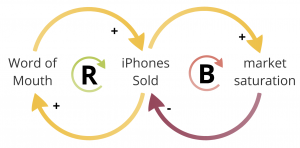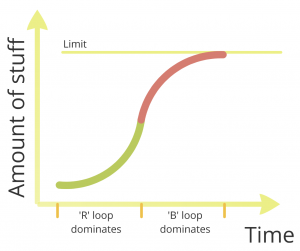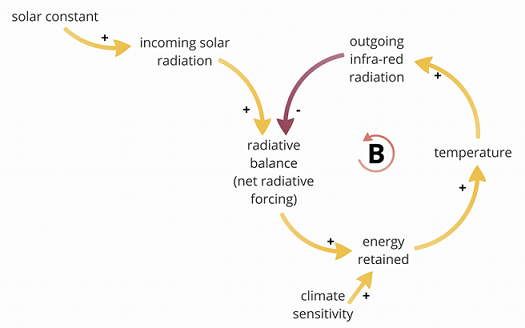
|
Mother Pelican
A Journal of Solidarity and Sustainability
Vol. 10, No. 2, February 2014
Luis T. Gutiérrez, Editor
|
|
|
|

|
|
|
The Climate as a System
Part 1: The Central Equilibrium Loop
Steve Easterbrook
Originally published in Serendipity, 22 August 2013
REPRINTED WITH PERMISSION
This is Part 1 of a series of articles
exploring the complex feedback dynamics of
GLOBAL CLIMATE CHANGE
For an analysis of the recently released IPCC report, click HERE
For a syllabus on systems thinking for global issues, click HERE
|
|
I wrote earlier this week that we should incorporate more of the key ideas from systems thinking into discussions about climate change and sustainability. Here’s an example: I think it’s very helpful to think about the climate as a set of interacting feedback loops. If you understand how those feedback loops work, you’ve captured the main reasons why climate change is such a massive challenge for humanity. So, this is the first in a series of posts where I attempt to substantiate my argument. I’ll describe the global climate in terms of a set of balancing and reinforcing feedback loops. (Note: This is a very elementary introduction. If you prefer a detailed mathematical treatment of feedbacks in the climate system, try this paper by Gerard Roe)
Before we start, we need some basic concepts. The first is the idea of a feedback loop. We’re used to thinking in terms of linear sequences of cause and effect: A causes B, which causes C, and so on. However, our interactions with the world are rarely like this. More often, change tends to feed back on itself. For example, we identify a problem that needs solving, we take some action to solve it, and that action ends up changing our perception of the problem. The feedback usually comes in one of two forms. The first is a balancing feedback: The more you try to change something, the more the world pushes back and makes it harder. Take dieting for example: if we manage to lose a few pounds, the sense of achievement can make us complacent, and then we put the weight all back on again. The second form is a reinforcing feedback. This is where success feeds on itself. For example, perhaps we try a new exercise regime, and it makes us feel energized, so we end up exercising even more, and so on.
In physics and engineering, these are usually called ‘positive’ and ‘negative’ feedback loops. I prefer to call them ‘reinforcing’ and ‘balancing’ loops, because it’s a better description of what they do. People tend to think ‘positive’ means good and ‘negative’ means bad. In fact, both types of loop can be good or bad, depending on what you think the system ought to be doing. A reinforcing loop is good when you want to achieve a change (e.g. your protest movement goes viral), but is certainly not good when it’s driving a change you don’t want (a forest fire spreading, for example). Similarly, a balancing loop is good when it keeps a system stable that you depend on (prices in the marketplace, perhaps), but is bad when it defeats your attempts to bring about change (as in the dieting example above).
It helps to draw pictures. Here’s an example of how both types of loop affect a tech company trying to sell a new product (say, the iPhone):

The action of reinforcing and balancing feedback loops in selling iPhones
|
You can read the arrows labelled “+” as “more of A tends to cause more of B than there otherwise would have been, while less of A tends to cause less of B than there otherwise would have been”. The arrows labelled “-” mean “more of A tends to cause less of B, and less of A tends to cause more of B”. [Note: there are some subtleties to this interpretation, but we can ignore them for now.]
On the left, we have a reinforcing loop (labelled with an ‘R’): the effect of word of mouth. The more iPhones we sell, the more people there are to spread the word, which in turn means more get sold. This tends to create an exponential growth in sales figures. However, this cannot go on forever. Sooner or later, the balancing loop on the right starts to matter (labelled with a ‘B’). The more iPhones sold, the fewer there are people left without one – we start to saturate the market. The more the market is saturated, the fewer iPhones we can sell. The growth in sales slows, and may even stop altogether. The resulting graph of sales over time might look like this:

How the sales of iPhones might look over time
|
When the reinforcing loop dominates, sales grow exponentially. When the balancing loop dominates, sales stagnate. In this case, the natural limit is when everyone who might ever want an iPhone has one. Of course, in real life, the curves are never this smooth – other feedback loops (that we haven’t mentioned yet) kick in, and temporarily push sales up or down. However, we could hypothesize that these two loops do explain most of the dynamic behaviour of the sales of a new product, and everything else is just noise. In many cases this is true – diffusion of innovation studies frequently reveal this type of S-shaped curve.
The structure of these two loops and the S-shaped curve they produce describe many real world phenomena: the spread of disease, growth of a population, the growth of a firm, the spread of a forest fire. In each case, there may well be other feedback loops that complicate the picture. But the underlying story about growth and its limits still captures a basic truth: exponential growth occurs when there is a reinforcing feedback loop, and as nothing can grow exponentially forever, there must always be a balancing loop somewhere that provides a limit to growth.
Okay, that’s enough background. Time to look at the first feedback loop in the global climate system. We’ll start with the global climate system in its equilibrium state – i.e. when the climate is not changing. The climate has been remarkably stable for the last 10,000 years, since the end of the last ice age. Over that time, it has varied only within less than 1°C. That stability suggests there are likely to be balancing feedback loops keeping it stable. The most important of these is the basic energy balance loop:

The Earth’s energy balance as a balancing loop
|
The temperature of the planet is determined primarily by the balance between the incoming energy from the sun and the outgoing energy lost back into space. The incoming energy is in the form of shortwave radiation from the sun, and the amount we get is determined by the solar constant (which, of course, is not really constant, although the variations were too small to measure before the satellite era). The incoming energy from the sun, averaged out over the surface of the earth, is about 340 watts per square meter. If this is greater than the outgoing energy, the imbalance causes the earth to retain more energy, and so the temperature rises. As a warmer planet loses energy faster, this increases the outgoing radiation, which in turn reduces the imbalance again (i.e. this is a balancing loop).
Imagine there’s an overshoot – i.e. the outgoing radiation rises, but goes a little too far, so that it’s now more than the incoming solar radiation. This reduces the net radiative forcing so far that it becomes negative. But a decrease in net radiative forcing tends to cause a decrease in energy retained, which causes a decrease in temperature, which causes a decrease in outgoing radiation again. So the balancing loop also cancels out any overshoot sooner or later. In other words, the structure of this loop always pushes the planet to find a (roughly) stable equilibrium: essentially, if the incoming and outgoing energy ever get out of balance, the temperature of the planet rises or falls until they are balanced again.
Note that we could tell this is a balancing loop, without tracing the effects, just by counting up the number of “-” links. If it’s an odd number, it’s a balancing loop; if it’s even (or zero), it’s a reinforcing loop. In my systems thinking class, we play a game that simulates different kinds of loop, with each person acting as one link (some are “+” links, some are “-” links). The students usually find it hard to predict how loops of different structure will behave, but once we’ve played it a few times, everyone has a good intuition for the difference between reinforcing loops and balancing loops.
There is one more complication for this loop. The net radiative forcing determines the rate at which energy is retained, rather than the total amount. If the net forcing is positive, the earth keeps on retaining energy. So although this leads to an increase temperature, and, if you follow the loop around, a decrease in the net radiative forcing, it will reduce the rate at which energy is retained (and hence the rate of warming), it won’t actually stop the warming until the net radiative balance falls to zero. And then, when the warming stops, it doesn’t cool off again – the loop ensures the planet stays at this new temperature. It’s a slow process because it takes time for the planet to warm up. For example, the oceans can absorb a huge amount of energy before you’ll notice any increase in temperature. This means the loop operates slowly. We know from simulations (and from studies of the distant past) that it can take many decades for the planet to find a new balance in response to a change in net radiative forcing.
There are, of course, other feedback loops to complicate the picture, and some of them are reinforcing loops. I’ll describe some of these in my next post. But from an understanding of this one loop, we can gain a number of insights:
- This loop, on its own, cannot produce a runaway global warming (or cooling) – the earth will eventually find a new equilibrium in response to a change in net radiative forcing. More precisely, for a runaway warming to occur, some other reinforcing loop must dominate this one. As I said, there are some reinforcing loops, and they complicate the picture, but nobody has managed to demonstrate that any of them are strong enough to overcome the balancing effect of this loop.
- The balancing loop has a delay, because it takes a lot of energy to warm the oceans. Hence, once a change starts in this loop, it takes many decades for the balancing effect to kick in. That’s the main reason why we have to take action on climate change many decades before we see the full effect. On human timescales, the earth’s natural balancing mechanism is a very slow process.
- If we make a one-time change to the radiative balance, the earth will slowly change its temperature until it reaches a new balance point, and then will stay there, because the balancing loop keeps it there. However, if there is some other force that keeps changing the radiative balance, despite this loop’s attempts to adjust, then the temperature will keep on changing. Our current dilemma with respect to climate change isn’t that we’ve made a one-time change to the amount of greenhouse gases in the atmosphere – the dilemma is that we’re continually changing them. This balancing loop only really helps once we stop changing the atmosphere.
ABOUT THE AUTHOR
Steve M. Easterbrook is a professor of Computer Science at the University of Toronto. Professor Easterbrook's research is focused on software engineering for climate system modeling, and the following is a list of recent publications:
- Engineering the Software for Understanding Climate Change, Steve M. Easterbrook and Timothy C. Johns, IEEE Computing in Science and Engineering, November 2009.
- Climate Change: A Software Grand Challenge, Steve M. Easterbrook, Serendipity, 24 August 2010.
- Guest Editors’ Introduction: Climate Change - Science and Software, S. M. Easterbrook, P. N. Edwards,V. Balaji, R. Budich, IEEE Software, 2011
- Why Systems Thinking?, Steve M. Easterbrook, Serendipity, 20 August 2013.
- The Climate as a System, part 1: the central equilibrium loop, Steve M. Easterbrook, Serendipity, 22 August 2013.
- The Climate as a System, part 2: energy consumption, Steve M. Easterbrook, Serendipity, 26 August 2013.
- The Climate as a System, part 3: greenhouse gases, Steve M. Easterbrook, Serendipity, 27 August 2013.
- The Climate as a System, part 4: earth system feedbacks, Steve M. Easterbrook, Serendipity, 2 September 2013.
- The Climate as a System, part 5: clouds, Steve M. Easterbrook, Serendipity, 3 September 2013.
-
What Does the New IPCC Report Say About Climate Change?, Steve M. Easterbrook, Serendipity, 8 October 2013.
- Systems Thinking for Global Problems, Steve M. Easterbrook, Graduate Course Outline, University of Toronto, 2 December 2013.
For more information about this author, see his UT Webpage and his Serendipity Blog.
|
|Back to Title|
Page 1
Page 2
Page 3
Page 4
Page 5
Page 6
Page 7
Page 8
Page 9
Supplement 1
Supplement 2
Supplement 3
Supplement 4
Supplement 5
Supplement 6
PelicanWeb Home Page
|
|
|
|
"Nature is the art of God."
— Dante Alighieri (1265–1321)
|
|
Page 8
|
|
FREE SUBSCRIPTION
|
![[groups_small]](groups_small.gif)
|
Subscribe to the
Mother Pelican Journal
via the Solidarity-Sustainability Group
Enter your email address:
|
|
|
|